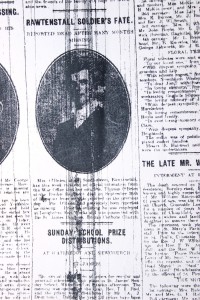Thomas William O’Brien, uncle of Tom Smith, currently St James the Less church’s oldest parishioner and himself a veteran of the Second World War, was the second child of Thomas William and Sarah O’Brien.
Born on 27th March 1890 and baptised little more than a week later, on 6th April, at St James the Less, Thomas was at least the third successive generation O’Brien to be named Thomas. His grandfather Thomas, who had emigrated to Haslingden from Roscommon in Ireland some 35 years earlier, to escape the devastation being caused there by the famine, was, no doubt, proud to be Thomas’ godfather at his baptism on that April day.
Over the next 20 years a further nine children were born into the family, with all eleven attending St James the Less church and school. The O’Briens lived in at least 2 houses in Daisy Hill, Rawtenstall, before moving to the nearby South Street, where they lived at no 24. The census of 1911 shows ten children at home in what was described as a house with 4 rooms; a typical ‘two up, two down’ terraced, built in the shadow of the nearby Higher Mill. This was the home from which Thomas went off to war some four years later.
On 31st August 1914, just 4 weeks after war was declared, Thomas left his job as a labourer at the Longholme Felt Works, travelled to Bury and enlisted for army service with the Border Regiment. He started his training the following day, travelling to the regiment’s barracks in Carlisle; quite probably the first time Thomas had been away from home.
Thomas’ training was to last for 6 months, but in March 1915, his military record shows that this was interrupted due to his father’s failing health, at the age of just 45 years. Thomas returned home and was with his father when he died on 17th March at 24 South Street. Just how long Thomas spent at home is unclear, but certainly it was less than a month later, on 14th April 1915, that he was posted to the regiment’s 2nd Battalion and deployed to France as part of the British Expeditionary Force. Thomas never returned home again.
September 1915 saw the launch of a major allied offensive by British and French troops against the German line in Artois and Champagne. One of the major battles in that offensive was the Battle of Loos, which commenced at dawn on the morning of 25th September and saw the first use of poisonous gas by the British Army on the battlefield.
Thomas was amongst the many soldiers who fell in the attacks on enemy lines on that first day. Launched in awful conditions, made worse by clouds of gas moving with the wind, Thomas, along with many others, fell and died in what was to become another strip of ‘no man’s land’, from which it became impossible to recover any remains until the battlefields were cleared from 1919 onwards. The front line remained at Loos until the end of the war and it was reported that, by late 1918, the land there resembled a ‘moonscape’, with very little of the original woods, roads or houses remaining to assist with the subsequent searching and locating of remains.
Thomas’s mother, Sarah, just six months after losing her husband, was informed that her son was missing in action, but had to wait a further five months until his death was confirmed, with the sad news being reported in the Rossendale Free Press on 12th February 1916.
A small war gratuity was paid to Sarah in August 1919, at which time she was still living at 24, South Street with a number of her children. One of her other sons, Joseph, was noted in Thomas’ military record, as living in the same street, at no 17.
A memorial for those who died in the battle was erected after the war around the perimeter of a cemetery just outside the village. The cemetery had been established by British troops, for those whose bodies were recovered. It was close to the front line and on land which had been an enemy stronghold, until captured by them.
Over 20,000 soldiers, killed in the Loos battle sector between 25th September 1915 and the end of the war and whose graves are still unknown, are commemorated on this memorial, including Thomas William O’Brien.


I am visiting The Somme and Ypres in July 2017. I was never aware of any relatives who were involved in the Great War but could never understand that there would be no connections whatsoever. On looking at this fascinating site, there is a name on the monument, Thomas William O’Brien. My grandmother, Teresa Whittaker (she married James Whittaker) was born O’Brien and was a member of this parish when growing up. In fact her requiem mass was held here in 1977 despite having lived in Blackpool since 1958. I was wondering if there could be any connection with her and Thomas William O’Brien at all. If anyone has any information, I would love to hear it and if there is a connection, I would love to visit the memorial to see his name there. Unfortunately my parents generation have all died out and I can’t ask anyone first hand. I am trying to find out some information but would be grateful if anyone can help. Many thanks. Lynn Davies, nee Perrin. (born Waterfoot 1954)